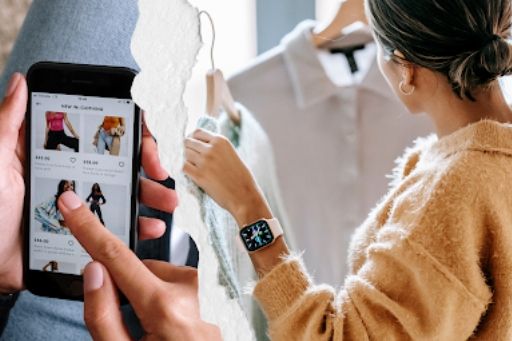
Are consumers spending more per visit in-store or online? If there’s one thing that we know for sure – it’s that ecommerce is not dead.
There are over 24 million ecommerce sites globally – accounting for more than 19% of all retail sales worldwide – with more and more emerging every day.
But do people prefer shopping in physical stores or online? What’s the difference?
Physical Store vs Online Store
IRL or URL? According to a Statista, only 26% of people in the UK prefer to shop in a physical store while 35% of consumers prefer to shop online and one of the most popular marketplaces is Amazon. The rest? Don’t mind which avenue they shop via – as long as they get what they are looking for.
In an era where consumers have the best of both worlds – the physicality of shopping in-store and/or online – what actually influences decisions and drives consumer shopping habits and purchase behaviour?
In this article we are going to focus on:
- User experience
- Shopping behaviour
User Experience In-Store and User Experience Online
User experience at brick-and-mortar stores is not dissimilar to user experience online. It’s all about a person’s perceptions of ease of use, utility and efficiency and the meaningful and relevant experiences that they have in your store. User experience is not only about technology but is also about understanding consumer behaviour in the offline world.
When used correctly to design both physical spaces and digital spaces, these experiential and visual interactions make shopping convenient and pleasing for the customer.
In-Store Shopping
The experience that a person has in a retail store all comes down to the design of the store. When a store design considers UX it means that the store is useful, easy to navigate and enjoyable to interact with. This means that: Creating a usable store layout that showcases product offerings, trends and content + a desirable and definitive user experience = the determining customer experience.
As customers walk throughout stores, stores want them to gain maximum exposure to their products – but how is this done without overwhelming the person and causing them stress and cognitive fatigue?
Stores add visual breaks (signage, seasonal displays, etc.) to different areas to grab their customers’ attention and highlight the products/services that are the most lucrative for the business. To enhance customer engagement, retailers can use Free QR Codes on signage, product displays, or promotional materials to provide instant access to product details, customer reviews, or exclusive offers. These QR codes allow shoppers to interact with the brand seamlessly while improving their in-store experience.
These breaks are also referred to as “speed bumps”. These visual intervals are not haphazard, rather, they help shoppers to visualise how products and services go together. Although this may seem like it is done for monetary reasons on the stores’ behalf – though at heart that is the goal – it is mainly done to communicate a story and connect the customer to the products/services and the brand.
Virtual Shopping and Online Shopping
Although both happen in a digital context, virtual shopping and online shopping are different and the experience that a person has can differ as well.
Think of a virtual store as an upgraded online eCommerce store. A virtual store takes the full browsing experience that a person would expect from a real, physical shop and makes it digital – bringing human connection to eCommerce.
Similarly to a physical store, the experience that a person has while virtual shopping online all comes down to the design of the eCommerce store. Attractive and aesthetic website designs have always played a crucial role in a successful online sales and marketing strategy, but they are not the only thing that determines the success of the site.
Good web designers can create beautiful designs with excellent colour palettes that increase the perceived value of the store’s products. Great web design experts, on the other hand, design for aesthetics as well as create the positive experience that consumers would expect in real life but from the comfort of their own homes.

UX Design Online
Successful online UX design means recreating those special touchpoints that a customer experiences when they make a purchase offline. Like when you’re waiting in line and you grab those last-minute small items before you get to the cashier.
Below we’ve listed 6 principles of UX design that our expert in-house designers say you can use to match user’s expectations online as you would in-store:

1) Focus on the user and meet their needs
Throughout the entire design process, focus on improving your users’ experience with your product or service. To do this, designers need to take into consideration what users are looking for in a design – this can be done through user testing and other user research methods. As a designer, it’s important to remember that your design may seem brilliant to you, but remember that you are not the user – so always keep them at the forefront of your mind.
2) Consistency is key
You don’t have to reinvent the wheel. Consistency makes the design process easier for the designers and users. The more familiar the website’s design is, the faster people can learn to use it, which enhances their experience.
When a user enters a website, they expect the site to share some similarities with other sites they regularly use. This makes it easy for them to become familiar with the new site without any additional learning costs. This helps to avoid cognitive fatigue and decreasing user anxiety and friction.
3) Have a clear hierarchy
Similarly to how physical stores add visual breaks to guide the person through their shopping experience, online stores do the same by ensuring that there is smooth navigation and visual hierarchy throughout a design. Create hierarchy through the website’s structural design and consider how the layout of content and information is organised throughout.
Fortunately, many no-code platforms such as Wix and Squarespace offer a wide range of drag-and-drop hierarchy templates, which allows for quick adjustments to website’s layout and content placement while maintaining a cohesive visual structure.
4) Tell a story
Through narrative design, designers can positively increase user experience for online retailers by telling a story with the design. A design that tells a championing story will feature compelling narrative elements, and defines the systems which will be delivered to the user.
Two vital elements to storytelling in design are rhythm and time. Rhythm is the pattern of unfolding that the narrative adopts – for example, the pattern of the sequence of screens through which the entire design opens up. If the pace is too slow, it can bore the user and cause a high bounce rate, as there’s not enough adequate information and content to hold their interest. Time is the pacing your design adopts – this means how quickly or slowly the narrative is unveiled.
5) Put the user in control
Work alongside a web developer to implement user control for your website. This will allow for considerable flexibility of use and greater control of where a user is within a design, enhancing their experience.
6) Understand accessibility
While designing a website, it’s vital to ensure that the design is usable for as many people as possible. This means that for people with disabilities, the design needs to be accessible for them too.
Need help understanding the user behaviour and conversion journeys of your customers?
Get in touch with our people experts.
Shopping Behaviour In-Store and Shopping Behaviour Online
Customer’s shopping habits in-store and online are very similar and can be separated into six categories:
- Social influence;
- Subconscious decision making;
- Building trust;
- Simplicity;
- Personal relevance;
- Design and navigation.

1) Social Influence
According to social psychologist Robert Cialdini, informational social influence – better known as social proof – is the idea that people copy the actions of others, setting out to mirror their behaviour in certain situations.
The same is true when people choose to shop in a particular store. Before people visit a store for the first time, they look for reviews, recommendations and ways that others have used a product before making their decision.
People collect buying recommendations from a different range of sources. According to the Digital Marketing Institute:
- 70% of young adults trust and get recommendations from influencers over traditional celebrities
- 49% of consumers all ages depend on influencer recommendations
- 74% of consumers trust social networks to guide their purchasing decisions
- 92% of consumers trust recommendations from friends and family
- While physically shopping in a store, 60% of consumers refer to social media or a blog to influence their purchase decision
2) Subconscious Decision Making
People often browse through everything because they don’t know what they like. Why is this? Well, when it comes to making a purchase, we as consumers make rational justifications and emotional decisions.
This is true for both online shopping and retail shopping. When it comes to making a purchase, people make instant decisions with their subconscious. As consumers, we experience social pressures that are learned and formed by social norms and expectations, which leads people away from what they actually like.
When people have to think about what they’re purchasing and have to explain their reasoning, their choice may change completely because the rational mind is involved – trying to reason the choice as it doesn’t understand why the subconscious is choosing to make this decision. Consumer’s rational thinking justifies their emotional choice so once consumers have decided that they like or don’t like a particular option, it’s difficult for them to change their mind.
3) Building Trust
In relation to decision simplicity, the word “trust” doesn’t relate to trusting the brand, it’s about trusting the information gathered and presented. When presenting information to potential customers and repeat customers, the messaging and content shouldn’t only focus on product features and benefits, but also the brand’s usage and decision criteria.
4) Simplicity
K.I.S.S. Although massively overused, the phrase still rings true! Simplicity always wins for decision-making. People tend to prefer things that are both familiar and easy to understand – this is known as cognitive fluency.
According to the Harvard Business Review, “people subconsciously use a “decision simplicity index” to gauge how easy it is to gather and understand (or navigate) information about a brand, how much they can trust the information they find, and how readily they can weigh their options”.
The easier a brand makes the purchase decision journey, the higher the decision-simplicity score will be. This means that a more simplistic purchase journey and user journey is more likely to have their products/services purchased by the consumers considering them than those who don’t.
5) Personal Relevance
Because user’s commit to a purchase – both in-store and online – they make both emotional decisions and rational justifications. It’s important for your brand to create an emotional connection as early as possible during the purchase journey.
6) Design and Navigation
In social settings, people’s biases tend to take over. Often the consumer’s lateral bias takes the wheel, causing them to intuitively turn right when entering a room. Not only is this true for retail stores as you’ve probably seen these asymmetries when people sit in cinemas, board aeroplanes, enter classrooms and walk towards an escalator in the tube station. The same is true for people when they browse online.
90% of people tend to start shopping along the right-hand side of the retail store. Online, users naturally scan a page in a horizontal movement, usually across the upper part of the content area, reading from left to right in an “F” or “Z” shape. Retailers should take advantage of people’s natural tendencies and the way in which they naturally browse a retail store and scan a webpage.
For retailers in-store, a “power wall” can be put up on the right side of the store to grab shoppers’ attention right away. Here retailers can arouse and entice their customer’s attention with a high-impact display. After the “power wall”, the design of the store could leverage a circular path starting on the right side of the store so that customers walk through the back of the store and then to the front again. Following this design not only increases the chances of a customer making a purchase as they browse but also strategically controls the flow of the traffic in the store, setting a well-thought-out user journey.
For online eCommerce retailers, the most important call-to-actions should be placed on the right side of the header and navigation so that they grab the attention of visitors instantly. The design of the website should guide the person into the conversion funnel focusing on the most important goal, getting them to shop!
In-Store vs. Online Differences for Consumers
Above we focussed on the two main differences between in-store and online shopping that store owners need to take into account when deciding which avenue to go down.
However, from a consumer perspective there are other factors that come into play when deciding how to shop:
- Physical presence vs. virtual presence:
- In-store shopping involves visiting a physical retail location where customers can touch, feel, and try out products before making a purchase.
- Online shopping takes place on the internet, allowing customers to browse and purchase products from the comfort of their homes using a computer or mobile device.
- Convenience:
- In-store shopping can be more time-consuming and may require travel to a physical store. However, it offers the immediate gratification of obtaining the product instantly.
- Online shopping is generally more convenient, allowing customers to browse a wide variety of products, compare prices, and get instant gratification from their purchases. It’s particularly convenient for those with busy schedules or limited mobility.
- Product selection:
- In-store shopping limits customers to the inventory available in a particular physical location. It may have a more limited selection compared to online stores.
- Online shopping provides access to a vast array of products from various retailers, often with more sizes, colours, and styles available.
- Price comparison:
- In-store shopping may require physically visiting multiple stores to compare prices, which can be time-consuming.
- Online shopping allows for easy price comparison by displaying prices from different sellers on the same platform. Various tools and websites make it simple to find the best deals.
- Personal interaction:
- In-store shopping provides face-to-face interactions with sales associates, allowing customers to ask questions, seek recommendations, and get personalised assistance.
- Buying online lacks the personal touch, but customer support is usually available through chat, email, or phone.
- Return process:
- In-store returns are typically straightforward, allowing customers to return items directly to the physical store.
- Online returns may involve shipping the product back, which can be an additional step and may incur additional shipping costs.
- Security concerns:
- In-store shopping involves physical transactions, reducing the risk of online security issues such as identity theft or credit card fraud.
- Online shopping requires customers to share personal and financial information, raising concerns about online security. However, secure payment gateways and encryption measures aim to mitigate these risks.
Summary
Consumers are casual and prefer online shopping due to convenience and the consistent experience that they have online. However, whether digital or physical, losing sight of who your customer is and how they change can negatively impact your business.
If you’re a physical retailer store owner or an eCommerce store owner, you have to understand what your customers actually want now and then begin to craft an experience that aligns with their expectations and appetite for shopping.
Put your customers at your core to ensure a consistent, unified experience at every touchpoint. Putting user experience first will allow retailers to create crucial recurring revenue streams which help to build business sustainability and stability by staying in front of where your customers are heading next. Need help with your Shopify site? Get help from our Shopify and ecommerce web experts.



